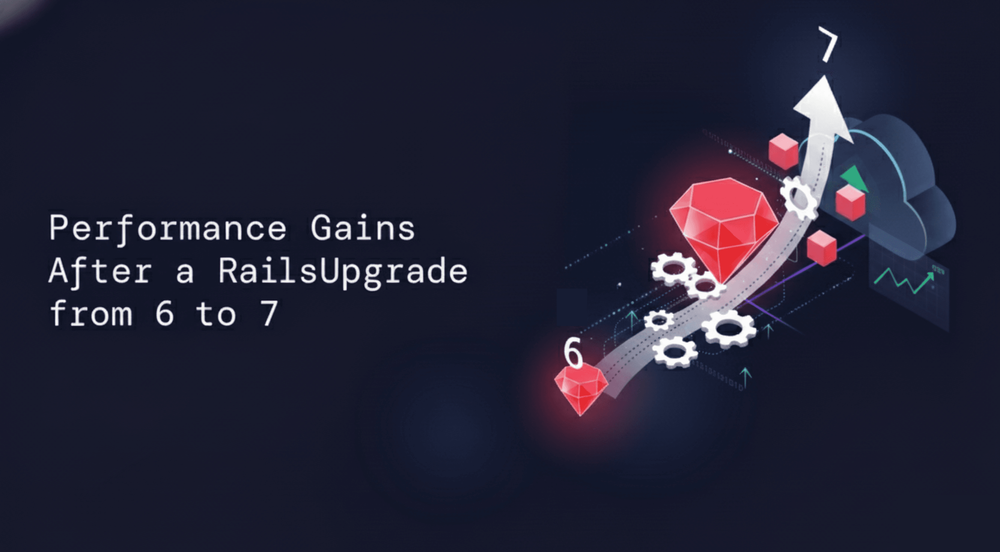The decision to upgrade your Rails application is never taken lightly. Development teams often weigh the effort against potential benefits, wondering if the investment will pay off. When it comes to a Rails upgrade from 6 to 7, the performance improvements alone make a compelling case for modernization.
Understanding the Performance Landscape
Rails 7 introduced several architectural changes that directly impact how your application processes requests and handles data. These improvements weren't just incremental tweaks but fundamental enhancements to the framework's core operations.
The most significant change is the introduction of encrypted attributes at the framework level. While this might seem like a security feature, it streamlines data handling by eliminating the need for third-party gems that often-added processing overhead. Your application now handles sensitive data more efficiently while maintaining stronger security standards.
Request Processing Speed
One of the immediate benefits teams notice after upgrading is faster request processing. Rails 7 optimizes the middleware stack, reducing the overhead each request encounters before reaching your application code. This translates to lower response times across all endpoints.
The query optimization improvements in Active Record deserve special attention. Rails 7 handles database queries more intelligently, reducing the number of unnecessary queries and improving the efficiency of eager loading. Applications with complex database relationships see the most dramatic improvements, with some teams reporting response time reductions of 20-30% on data-heavy pages.
Asset Pipeline Evolution
The shift from Webpacker to import maps and modern JavaScript bundling represents a philosophical change in how Rails handles frontend assets. This transition delivers tangible performance benefits both during development and in production.
Development environments feel noticeably snappier. The asset compilation process that once took several seconds now happens almost instantaneously. This might seem minor but multiply those seconds across hundreds of daily code changes, and you're saving hours of developer time each week.
Production asset delivery also improved. The new approach generates smaller JavaScript bundles and leverages browser caching more effectively. Users experience faster initial page loads and smoother interactions as the browser can cache and reuse assets more efficiently.
Turbo and Stimulus Improve Page Interactions
Rails 7 encourages teams to adopt Turbo and Stimulus. These libraries replace large amounts of custom JavaScript with lightweight, well-structured interactions. In many cases, the performance benefits come from removing unnecessary JavaScript code that your browser no longer needs to process.
Turbo improves performance by allowing partial page updates instead of full reloads. Pages feel quicker because the browser updates only the required areas. For applications with dashboards, carts, feeds, and interactive forms, this has a big impact on perceived performance.
Stimulus keeps JavaScript small and organized, which improves maintainability along with performance. When you depend less on bulky client-side frameworks, you usually see improved load times and a smoother experience.
Also Read: A Complete Guide to Upgrading Your Rails from 7.2 to 8.0
Memory Management Improvements
Rails 7 introduced refinements to how the framework manages memory, particularly in how it handles object allocation and garbage collection. Applications running on Rails 7 typically show lower memory consumption compared to their Rails 6 counterparts handling identical workloads.
This improvement becomes crucial when scaling your application. Lower memory usage means you can handle more concurrent users with the same infrastructure, or alternatively, reduce your server costs while maintaining the same capacity. Several production deployments have reported 15-20% reductions in memory usage after upgrading.
Preparing for Your Upgrade Journey
Before beginning a Rails upgrade from 6 to 7, thorough preparation prevents surprises and ensures a smooth transition. Start by running a rails compatibility checker against your current codebase. This tool identifies deprecated methods, incompatible gems, and potential breaking changes that require attention.
A comprehensive rails upgrade checklist should include auditing your dependencies, reviewing custom middleware, and testing third-party integrations. Many gems that worked perfectly in Rails 6 may need updates or replacements for Rails 7 compatibility.
Database migrations deserve careful review. While Rails 7 maintains backward compatibility with most migration patterns, some advanced features and custom SQL might behave differently. Testing migrations in a staging environment catches potential issues before they impact production.
The Role of Professional Support
While many teams successfully handle upgrades internally, others benefit from specialized rails upgrade services. These services bring experience from dozens of upgrade projects, helping you avoid common pitfalls and accelerate the process.
Professional upgrade teams typically complete the work in a fraction of the time it takes in-house teams, simply because they've encountered and solved the same problems repeatedly. They also bring testing strategies and rollback procedures refined across many projects.
The cost of professional Rails upgrade services often proves lower than the opportunity cost of pulling senior developers away from feature development for weeks. This becomes especially true for larger applications where the upgrade complexity grows exponentially with codebase size.
Testing Your Performance Gains
After upgrading, measuring performance improvements validates your investment and helps communicate success to stakeholders. Focus on metrics that matter to your business: response times, throughput, error rates, and resource utilization.
Establish baseline measurements before upgrading. Run load tests that simulate realistic traffic patterns and record key metrics. After upgrading, repeat these tests under identical conditions to quantify improvements.
Monitor production performance closely during the first few weeks. While testing catches most issues, real-world traffic patterns sometimes reveal optimization opportunities that synthetic tests miss.
Also Read: The Ultimate Rails Upgrade Guide for 2025
Long-Term Benefits Beyond Performance
The performance gains represent just one category of benefits from upgrading to Rails 7. You also gain access to new framework features that enable better application architecture and improved developer productivity.
Staying current with Rails versions reduces technical debt and makes future upgrades easier. The gap between Rails 6 and 7 is manageable, but waiting longer creates larger gulfs that become exponentially harder to bridge.
Security updates represent another crucial consideration. While Rails 6 still receives security patches, Rails 7 benefits from more active development and faster response to emerging threats.
Moving Forward
The performance improvements in Rails 7 make a strong case for upgrading, but they're part of a larger story about application health and sustainability. Modern frameworks, reduced technical debt, and access to new features create compounding benefits over time.
Whether you tackle the upgrade internally or engage Rails upgrade services, the key is moving forward deliberately and systematically. With proper planning, testing, and execution, your Rails upgrade from 6 to 7 delivers immediate performance benefits while positioning your application for future growth and evolution.


